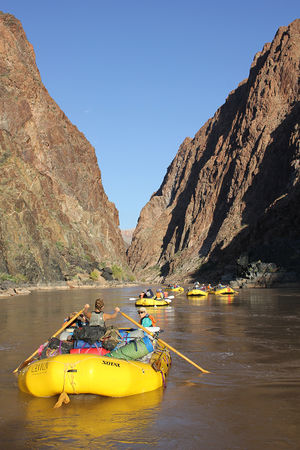Difference between revisions of "Bishop Study"
Cellsworth (Talk | contribs) |
Cellsworth (Talk | contribs) |
||
| Line 21: | Line 21: | ||
|style="width:60%; font-size:95%;"| | |style="width:60%; font-size:95%;"| | ||
| − | ==The 1987 Bishop Study == | + | =='''The 1987 Bishop Study''' == |
The research reported here focused on the effects of Glen Canyon Dam operations on the quality of | The research reported here focused on the effects of Glen Canyon Dam operations on the quality of | ||
recreation downstream. Two types of | recreation downstream. Two types of | ||
| Line 76: | Line 76: | ||
|- | |- | ||
| − | ! <h2 style="margin:0; background:#cedff2; font-size:120%; font-weight:bold; border:1px solid #a3bfb1; text-align:left; color:#000; padding:0.2em 0.4em;"> The 8k Cap </h2> | + | ! <h2 style="margin:0; background:#cedff2; font-size:120%; font-weight:bold; border:1px solid #a3bfb1; text-align:left; color:#000; padding:0.2em 0.4em;"> The 8k Cap and the 10,000 cfs Fluctuation Threshold </h2> |
|- | |- | ||
|style="color:#000;"| | |style="color:#000;"| | ||
| − | + | "The study assessed the recreational impacts of two characteristics of dam releases: (a) average daily flow; and (b) whether flows were constant or fluctuating on a daily basis. Average daily flows were characterized in terms of the mean release rate at the dam in cfs. '''Flows were classified as "constant daily flows" if the difference between the minimum and maximum release at the dam during a 24-hour day was less than 10,000 cfs. If this difference was greater than or equal to 10,000 cfs, then the flow on that day was classified as a "fluctuating daily flow." ''' Based on survey research, described below, the 10,000 cfs threshold was determined to be the point at which fluctuations begin to be perceptible to recreationists." (page 412 of [http://www.swrcb.ca.gov/water_issues/programs/ocean/cwa316/docs/cwa316may2010/comments041310/bishop_etal.pdf Bishop et al. 1987]) | |
| − | Additionally, Stewart et al.’s (2000) follow-up of the Bishop et al. (1987) study found that angler’s did not identify river level fluctuations, at least under the MLFF operating regime, as an issue. Based on information from Stewart et al (2000) and Bishop et al. (1987), | + | Additionally, [http://www.gcmrc.gov/library/reports/cultural/Recreation/Stewart2000.pdf Stewart et al.’s (2000)] follow-up of the [http://www.swrcb.ca.gov/water_issues/programs/ocean/cwa316/docs/cwa316may2010/comments041310/bishop_etal.pdf Bishop et al. (1987)] study found that angler’s did not identify river level fluctuations, at least under the MLFF operating regime, as an issue. Based on information from [http://www.gcmrc.gov/library/reports/cultural/Recreation/Stewart2000.pdf Stewart et al.’s (2000)] and [http://www.swrcb.ca.gov/water_issues/programs/ocean/cwa316/docs/cwa316may2010/comments041310/bishop_etal.pdf Bishop et al. (1987)], any flow fluctuation below 10,000 cfs/day should be treated the same as a steady flow release. |
---- | ---- | ||
Revision as of 11:07, 28 August 2019
|
|
The 1987 Bishop StudyThe research reported here focused on the effects of Glen Canyon Dam operations on the quality of recreation downstream. Two types of recreation were studied in detail, fishing and white-water boating. From a recreational perspective, different discharges from the dam affect the conditions under which downstream fishing and white-water boating occur. Flows in the river could be a significant determinant of recreational quality. The study was conducted as part of the Glen Canyon Environmental Studies (GCES), a multi-agency effort to examine the impacts of dam operations on the environmental and recreational resources downstream. The mission of the initial phase of GCES was to determine whether operations were adversely affecting downstream environmental and recreational resources and, if so, whether ways could be found, within existing institutional constraints, to improve or better protect environmental and recreational resources. The overall goal of GCES -- and hence the work on recreation reported here -- was not to prescribe specific actions to be taken, since this would have involved much broader trade-offs between recreation, power generation, environmental effects, and other social objectives. Rather, our goals were the more limited ones of determining the effects of dam operations on recreational quality and developing options that would benefit recreation considered alone. The results reported here will eventually be combined with results from studies on the downstream environment, electric power generation, and other resources in order to construct and evaluate dam management options. We used dollar measures to quantify recreational impacts. Thus, the study design, as described later in the paper, was built on theoretical links between environmental quality and consumer surplus explored thoroughly by Maler (1974) and Freeman (1979). Using dollar values not only conveys recreational quality impacts in a commonly used metric, but may also eventually facilitate the analysis of trade-offs between recreation and other goals using the tools of benefit-cost analysis. In the next section, the relationships between dam operations and recreation will be explored. Following this, the design of the study is summarized and the measured consumer surplus values for fishing and boating reported. We then illustrate ways that dam operations could be modified to improve downstream recreation.[1] |
| --- | --- | --- |
|---|
|
|
